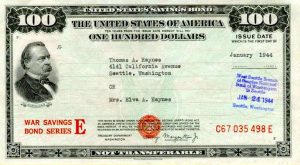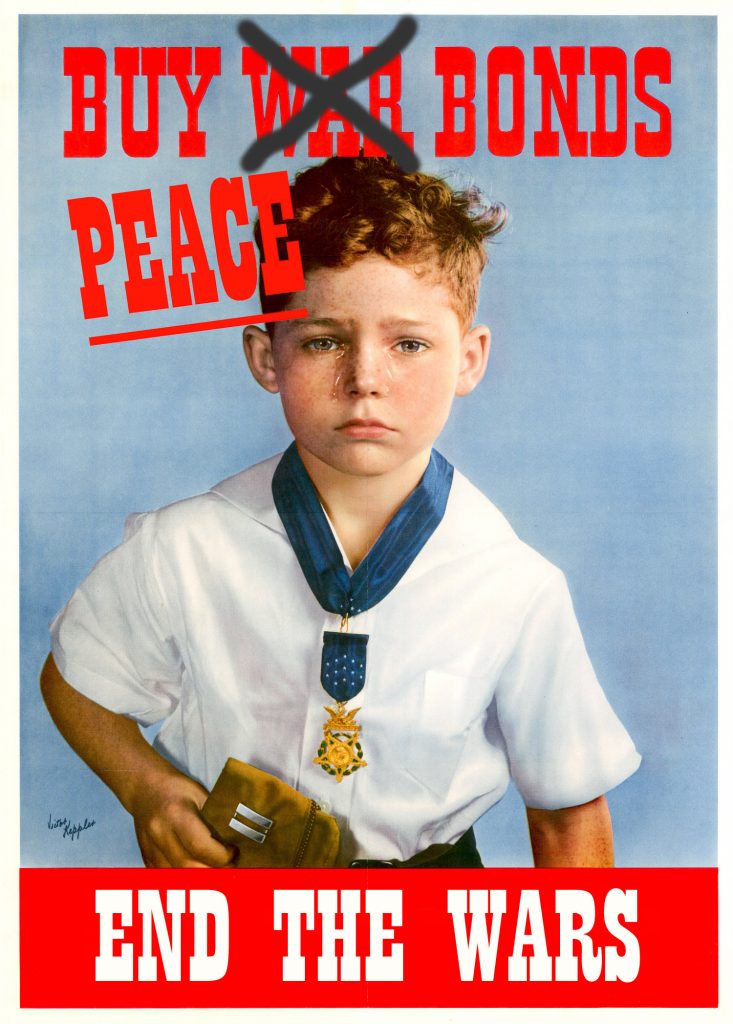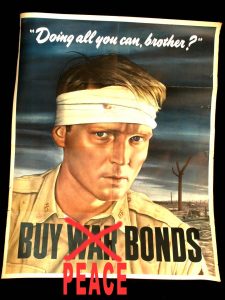 Funding war has always been a priority. Funding peace is another matter.
Funding war has always been a priority. Funding peace is another matter.
In World War I, the U.S. issued Liberty Bonds to raise money for the war. Before World War II, Series E, F and G U.S. Savings Bonds were being promoted. Right after the attack on Pearl Harbor, these were sold as War Bonds. After the war, the name was switched back.
Many older folks out there will remember U.S. Savings Bonds being popular when they were kids. They were promoted as birthday and graduation presents and remained in the spotlight right up until five to ten years ago, when people were no longer inclined or able to save money, therefore they stopped buying them.
 I can find no record in our history books of anything called Peace Bonds in America.
I can find no record in our history books of anything called Peace Bonds in America.
There should be.
If we can raise money for war, we most certainly can raise money for peace.
For individual citizens who actively want to promote peace, some of the money they get as their Peace Dividend Refund could be invested back into funding the Peace Dividend effort as a whole.
Meaning, those individuals who aren’t pressed for immediate cash, thus don’t need the entire amount of cash payment for their Peace Dividend Refund right away, could opt to receive all or part of it in the form of Peace Bonds, an investment in America’s future that would accrue interest and be part of national commitment to focus on peace instead of war.
Once the Peace Dividend refunds are funded by whatever combination of monetary devices works, additional Peace Bonds could be sold on the global bond market, inviting other countries to invest in promising new peace initiatives. Contrary to the paranoiac propaganda which bombards U.S. citizens 24/7, the majority of other nations in the world would welcome the prospect of investing in projects which would reduce aggression and conflict, and promote harmony and peaceful coexistence.
 Understand that this is not some neo-hippie pipe dream. Peace Bonds will play an essential role in shifting the national consciousness and narrative away from war, hopefully even rehabilitating America’s image in the international community as a war-obsessed bully. It seems everything in America now is about the military, war, fighting, bombing, droning. The peace movement is all but dead. Just seeing the word ‘peace’ occasionally might be a refreshing change. It might steer people to thinking about world peace as a purposeful and relevant pursuit, not just prattle from beauty pageant contestants.
Understand that this is not some neo-hippie pipe dream. Peace Bonds will play an essential role in shifting the national consciousness and narrative away from war, hopefully even rehabilitating America’s image in the international community as a war-obsessed bully. It seems everything in America now is about the military, war, fighting, bombing, droning. The peace movement is all but dead. Just seeing the word ‘peace’ occasionally might be a refreshing change. It might steer people to thinking about world peace as a purposeful and relevant pursuit, not just prattle from beauty pageant contestants.
On a practical level, a robust Peace Bond approach could create many new opportunities for social, economic, and political renewal: 1) furnish necessary funding for the transitioning of industries and their workers to non-military production; 2) underwrite both domestic and international service programs modeled on the Peace Corps, creating opportunities for citizens to make a positive contribution to the world; 3) replace the predatory lending of the World Bank and IMF with financial backing for “win-win” investment in the developing world; 4) provide no-strings-attached emergency relief as unexpected natural catastrophes require it; 5) mitigate the accelerating wealth inequality in the world by directly addressing at an international level poverty and health issues, and building eco-friendly, sustainable Third World infrastructure.
 All of this represents a 180º reversal of the current paradigm based on conquest and colonialism. It will take a while to repair the enormous damage done to the image and reputation of our country with its never-ending wars of aggression and regime change. But eventually, through a sustained effort and genuine commitment, the U.S. could again be seen as a force for good, deserving of the high praise it now heaps on itself as promoter of freedom, democracy, human rights, equality, and justice.
All of this represents a 180º reversal of the current paradigm based on conquest and colonialism. It will take a while to repair the enormous damage done to the image and reputation of our country with its never-ending wars of aggression and regime change. But eventually, through a sustained effort and genuine commitment, the U.S. could again be seen as a force for good, deserving of the high praise it now heaps on itself as promoter of freedom, democracy, human rights, equality, and justice.
Peace Bonds are an idea whose time has come. Funding initially the Peace Dividend Refund and then future projects which promote cooperation and harmony instead of confrontation and chaos, they are a positive and necessary step in breaking the U.S. addiction to war and transforming the war economy into a multi-faceted, holistic mechanism which serves all of the people. They are a key element in recreating a nation which directs energy and resources to the future we want and our children deserve.



